英语模拟上课讲课稿
- 格式:docx
- 大小:11.14 KB
- 文档页数:2
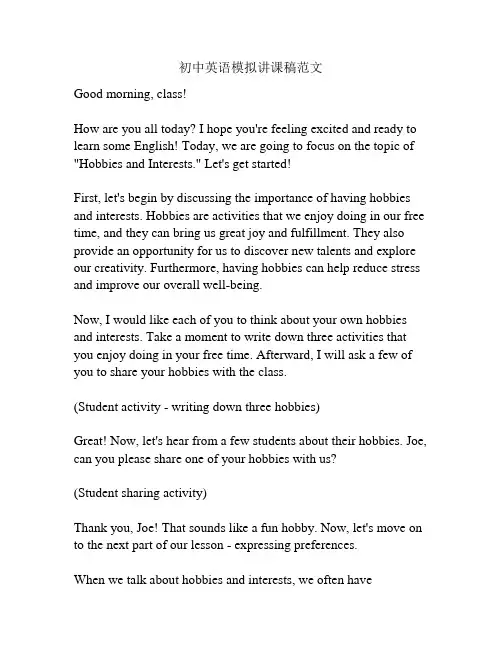
初中英语模拟讲课稿范文Good morning, class!How are you all today? I hope you're feeling excited and ready to learn some English! Today, we are going to focus on the topic of "Hobbies and Interests." Let's get started!First, let's begin by discussing the importance of having hobbies and interests. Hobbies are activities that we enjoy doing in our free time, and they can bring us great joy and fulfillment. They also provide an opportunity for us to discover new talents and explore our creativity. Furthermore, having hobbies can help reduce stress and improve our overall well-being.Now, I would like each of you to think about your own hobbies and interests. Take a moment to write down three activities that you enjoy doing in your free time. Afterward, I will ask a few of you to share your hobbies with the class.(Student activity - writing down three hobbies)Great! Now, let's hear from a few students about their hobbies. Joe, can you please share one of your hobbies with us?(Student sharing activity)Thank you, Joe! That sounds like a fun hobby. Now, let's move on to the next part of our lesson - expressing preferences.When we talk about hobbies and interests, we often havepreferences for certain activities. For example, some people prefer outdoor activities such as playing football or hiking, while others prefer indoor activities like reading or playing video games. It's important to express our preferences and also respect the preferences of others.To practice expressing preferences, I have prepared a worksheet for each of you. On the worksheet, you will find a list of activities. Your task is to write "like" or "dislike" next to each activity based on your personal preference.(Student activity - completing the worksheet)Well done, everyone! Now, let's share our preferences with the class. Anna, can you please tell us about one activity that you like? (Student sharing activity)Thank you, Anna! It's interesting to hear about your preference. Now, let's move on to the next part of our lesson - talking about frequency.When we talk about hobbies, we can also discuss how often we engage in these activities. For example, some people may have a hobby they do every day, while others may only do it once a week or even less frequently. Discussing frequency can help us understand each other better and find common interests.To practice talking about frequency, I will divide you into pairs. In your pairs, you will take turns asking each other how often you docertain activities. For example, one person may ask, "How often do you read books?" and the other person will respond with their frequency, such as "I read books every day" or "I read books once a week."(Student activity - practicing talking about frequency in pairs)Excellent job, everyone! It's clear that you all understand how to talk about frequency. Now, let's move on to the final part of our lesson - discussing new hobbies.Having hobbies and interests is great, but it's also important to try new things and discover new activities that we might enjoy. By exploring new hobbies, we can broaden our horizons, meet new people, and gain new skills.To encourage you to try new hobbies, I have prepared a brainstorming activity. In groups of three, you will have five minutes to brainstorm and write down five new hobbies that you would like to try in the future. Afterward, I will ask a few groups to share their ideas with the class.(Student activity - brainstorming and sharing new hobbies)Well done, everyone! It's fantastic to see that you all have a lot of ideas for new hobbies. Remember, trying new activities can be a lot of fun, so don't be afraid to step out of your comfort zone and explore new things.That brings us to the end of today's lesson on hobbies and interests.I hope you enjoyed learning about the importance of having hobbies, expressing preferences, talking about frequency, and discovering new activities. Remember to continue pursuing your hobbies and exploring new interests in your free time.Thank you for your attention today, and I look forward to seeing you all next time. Have a great day!。
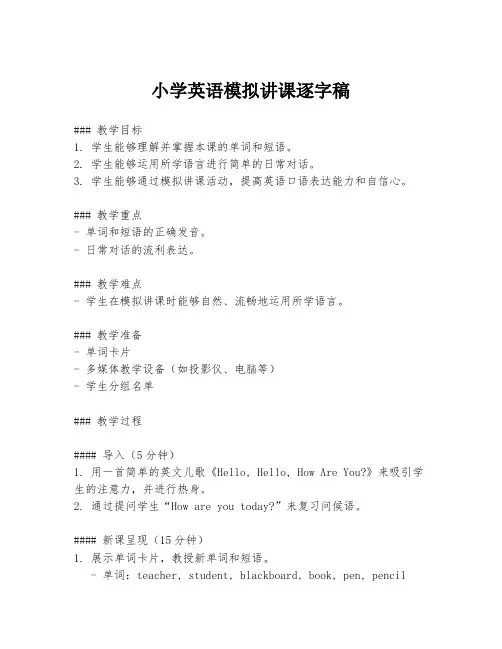
小学英语模拟讲课逐字稿### 教学目标1. 学生能够理解并掌握本课的单词和短语。
2. 学生能够运用所学语言进行简单的日常对话。
3. 学生能够通过模拟讲课活动,提高英语口语表达能力和自信心。
### 教学重点- 单词和短语的正确发音。
- 日常对话的流利表达。
### 教学难点- 学生在模拟讲课时能够自然、流畅地运用所学语言。
### 教学准备- 单词卡片- 多媒体教学设备(如投影仪、电脑等)- 学生分组名单### 教学过程#### 导入(5分钟)1. 用一首简单的英文儿歌《Hello, Hello, How Are You?》来吸引学生的注意力,并进行热身。
2. 通过提问学生“How are you today?”来复习问候语。
#### 新课呈现(15分钟)1. 展示单词卡片,教授新单词和短语。
- 单词:teacher, student, blackboard, book, pen, pencil- 短语:speak English, listen carefully, write down2. 通过图片和实物来辅助教学,帮助学生更好地理解和记忆。
3. 播放一段简短的英语对话视频,让学生模仿并练习。
#### 操练(15分钟)1. 分组练习:将学生分成小组,每组选择一个角色(老师、学生)进行模拟讲课。
2. 每组学生轮流模拟讲课,其他学生扮演学生角色,进行互动。
3. 教师巡视指导,及时纠正发音和语法错误。
#### 应用(10分钟)1. 模拟讲课展示:每组选出一名代表,到前面进行模拟讲课。
2. 其他学生和教师给予反馈和鼓励。
#### 总结(5分钟)1. 回顾本课所学的单词和短语。
2. 强调模拟讲课的重要性,鼓励学生在日常生活中多练习英语口语。
#### 作业布置1. 准备一个简短的英语自我介绍,下节课进行展示。
2. 复习本课所学的单词和短语,并尝试用它们造句。
### 板书设计- 单词:teacher, student, blackboard, book, pen, pencil- 短语:speak English, listen carefully, write down通过这样的教学设计,学生不仅能够学习到新的英语知识,还能在模拟讲课的活动中提高口语能力,增强自信心。
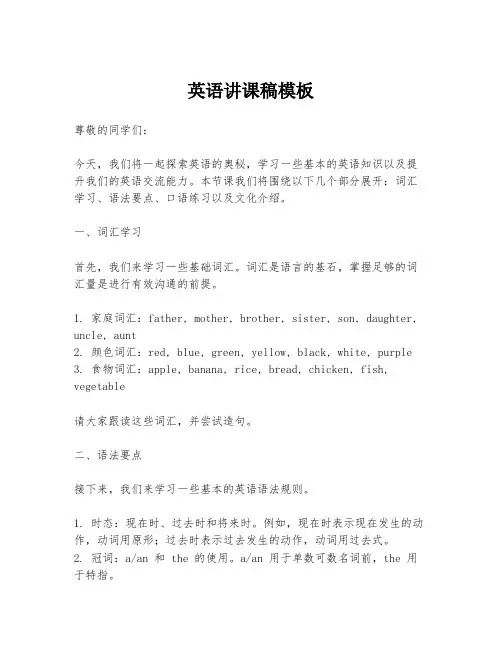
英语讲课稿模板尊敬的同学们:今天,我们将一起探索英语的奥秘,学习一些基本的英语知识以及提升我们的英语交流能力。
本节课我们将围绕以下几个部分展开:词汇学习、语法要点、口语练习以及文化介绍。
一、词汇学习首先,我们来学习一些基础词汇。
词汇是语言的基石,掌握足够的词汇量是进行有效沟通的前提。
1. 家庭词汇:father, mother, brother, sister, son, daughter, uncle, aunt2. 颜色词汇:red, blue, green, yellow, black, white, purple3. 食物词汇:apple, banana, rice, bread, chicken, fish, vegetable请大家跟读这些词汇,并尝试造句。
二、语法要点接下来,我们来学习一些基本的英语语法规则。
1. 时态:现在时、过去时和将来时。
例如,现在时表示现在发生的动作,动词用原形;过去时表示过去发生的动作,动词用过去式。
2. 冠词:a/an 和 the 的使用。
a/an 用于单数可数名词前,the 用于特指。
3. 代词:人称代词、物主代词和反身代词的使用。
让我们通过几个例句来加深理解:- She is reading a book. (现在时)- He read a book yesterday. (过去时)- The book is on the table. (定冠词的使用)三、口语练习现在,让我们进行一些口语练习,提高我们的发音和流利度。
1. 角色扮演:假设你在一个餐厅,点餐时需要使用到的英语表达。
2. 日常对话:模拟购物、问路、打电话等场景。
3. 故事复述:听一个简短的英语故事,然后用自己的语言复述。
请大家积极参与,不要担心犯错。
犯错是学习过程的一部分。
四、文化介绍最后,我们来了解一些英语国家的文化。
1. 节日:圣诞节、感恩节、复活节等英语国家的重要节日及其传统。
2. 风俗习惯:餐桌礼仪、见面礼节等。
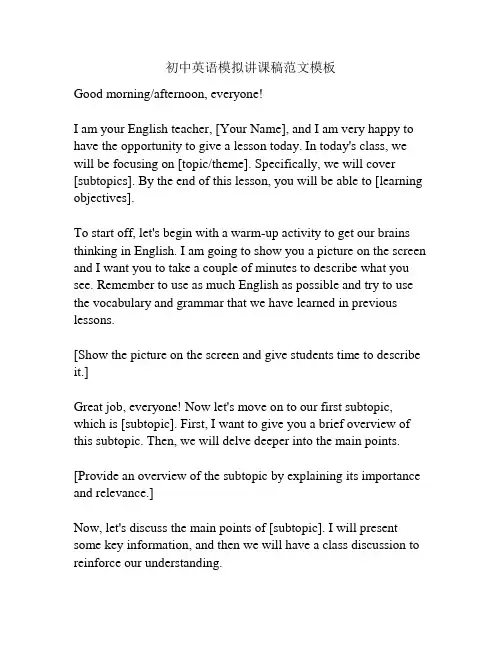
初中英语模拟讲课稿范文模板Good morning/afternoon, everyone!I am your English teacher, [Your Name], and I am very happy to have the opportunity to give a lesson today. In today's class, we will be focusing on [topic/theme]. Specifically, we will cover [subtopics]. By the end of this lesson, you will be able to [learning objectives].To start off, let's begin with a warm-up activity to get our brains thinking in English. I am going to show you a picture on the screen and I want you to take a couple of minutes to describe what you see. Remember to use as much English as possible and try to use the vocabulary and grammar that we have learned in previous lessons.[Show the picture on the screen and give students time to describe it.]Great job, everyone! Now let's move on to our first subtopic, which is [subtopic]. First, I want to give you a brief overview of this subtopic. Then, we will delve deeper into the main points.[Provide an overview of the subtopic by explaining its importance and relevance.]Now, let's discuss the main points of [subtopic]. I will present some key information, and then we will have a class discussion to reinforce our understanding.[Present key information using a combination of visuals, examples, and explanations.]Now, let's have a class discussion to reinforce our understanding. I will divide you into groups of [number] and provide each group with a question related to [subtopic]. Please discuss the question within your group and come up with a group answer. After [number] minutes, I will select one group to share their answer with the class. Remember to use English-only during the discussion.[Divide students into groups and provide them with a question related to the subtopic.][Give students time to discuss the question within their groups.] [Select one group to share their answer with the class.]Thank you, [group name], for sharing your answer. I think it was a great contribution to our class discussion. Now, let's move on to our next subtopic, which is [subtopic]. This subtopic is closely related to [previous subtopic], and it will further enhance our understanding of [topic/theme].[Provide an overview of the subtopic by explaining its relationship to the previous subtopic and its importance in building overall knowledge.]Now, let's dive deeper into the main points of [subtopic]. I will provide you with additional information, and then we will haveanother class discussion to solidify our understanding. [Present additional information using visuals, examples, and explanations.]Now it's time for our second class discussion. This time, I will form new groups and give each group a different question related to [subtopic]. Please discuss the question within your group and come up with a group answer. After [number] minutes, I will select one group to share their answer with the class.[Divide students into new groups and provide them with a question related to the subtopic.][Give students time to discuss the question within their groups.] [Select one group to share their answer with the class.]Thank you, [group name], for sharing your answer. I appreciate your unique perspective on the topic. Now, let's move on to our final subtopic, which is [subtopic]. This subtopic will tie all of our previous knowledge together and provide us with a comprehensive understanding of [topic/theme].[Provide an overview of the final subtopic by explaining its significance in connecting all the subtopics and reinforcing the overall understanding.]Next, I will present you with the final set of key information about [subtopic]. Pay close attention as this is the last piece of the puzzlebefore we move on to our final activity.[Present key information using visuals, examples, and explanations.]Now that we have covered all the subtopics, it's time for our final activity. I want you to think about how the subtopics we have discussed today are connected and how they relate to the overall topic/theme. I will give you a few minutes to write a short paragraph summarizing your understanding. After that, I will invite a few students to share their summaries with the class.[Give students time to write their summaries.][Invite students to share their summaries with the class.]Thank you, [student names], for sharing your summaries. I appreciate your thoughtful insights. It seems like everyone has developed a solid understanding of [topic/theme] and its various subtopics.To wrap up our lesson, I want to congratulate each and every one of you for actively participating and engaging in today's class. I'm very proud of your progress, and I encourage you to continue practicing your English skills outside of the classroom.Before we end, I will assign a small homework task that aligns with today's lesson. Please complete [homework task] and submit it by [due date]. Remember, practice makes perfect, so do your best!Thank you all for your hard work and attention today. I hope you found this lesson informative and enjoyable. Have a great day, and I'll see you next time![Optional: Additional time for questions and answers.]。

初二英语模拟讲课稿范文Good morning, everyone!Today, I am going to talk about the environment. As we all know, the environment is a topic that has been widely discussed in recent years. With the increasing pollution and global warming, it has become more important than ever for us to take action to protect our environment.Firstly, let's talk about pollution. Pollution comes in many forms, such as air pollution, water pollution, and land pollution. Air pollution is caused by the release of harmful gases and particles into the air. This can lead to respiratory problems and other health issues. Water pollution occurs when harmful substances are released into rivers, lakes, and oceans. It can seriously harm aquatic life and make water unsafe for drinking and other purposes. Lastly, land pollution occurs when chemicals and other harmful materials are dumped onto the ground. This can contaminate soil and lead to the destruction of ecosystems.So, what can we do to reduce pollution? There are several things we can do. Firstly, we can reduce our use of cars and opt for more environmentally-friendly modes of transportation such as walking, cycling, or using public transport. This will help to reduce air pollution. We can also save energy by turning off lights and appliances when they are not in use, and by using energy-efficient products. Additionally, we can recycle and reuse materials instead of throwing them away. This will help to reduce the amount of waste that ends up in landfills.Next, let's discuss global warming. Global warming is the gradual increase in the Earth's temperature due to the release of greenhouse gases into the atmosphere. This phenomenon has serious consequences, such as the melting of polar ice caps, rising sea levels, and extreme weather events. It is largely caused by human activities, such as burning fossil fuels for energy and deforestation.So, what can we do to combat global warming? Firstly, we can reduce our carbon footprint by using renewable sources of energy, such as solar power and wind power, instead of fossil fuels. We can also plant more trees, as they absorb carbon dioxide from the atmosphere and release oxygen. Additionally, we can support organizations and initiatives that are working towards reducing greenhouse gas emissions and protecting the environment.Lastly, let's talk about the importance of biodiversity. Biodiversity refers to the variety of life on Earth, including plants, animals, and microorganisms. It is important for the functioning of ecosystems and for the well-being of human beings. However, biodiversity is currently under threat due to habitat loss, pollution, and climate change.So, what can we do to protect biodiversity? Firstly, we can support conservation efforts by visiting national parks and nature reserves, and learning about the different species that inhabit these areas. We can also reduce our use of pesticides and fertilizers, as they can harm biodiversity. Furthermore, we can avoid buying products made from endangered species, such as ivory and fur. By taking these actions, we can contribute to the preservation of biodiversity.In conclusion, it is our responsibility to protect the environment. By reducing pollution, combating global warming, and protecting biodiversity, we can ensure a better future for ourselves and future generations. Remember, every little action counts, so let's all do our part to make a difference.Thank you for listening!。
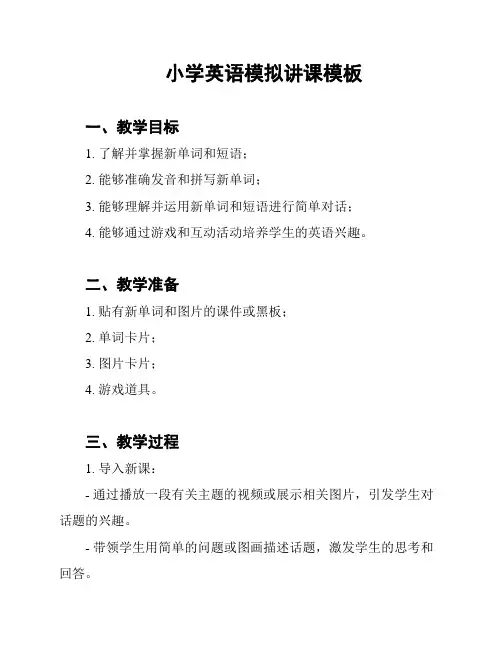
小学英语模拟讲课模板一、教学目标1. 了解并掌握新单词和短语;2. 能够准确发音和拼写新单词;3. 能够理解并运用新单词和短语进行简单对话;4. 能够通过游戏和互动活动培养学生的英语兴趣。
二、教学准备1. 贴有新单词和图片的课件或黑板;2. 单词卡片;3. 图片卡片;4. 游戏道具。
三、教学过程1. 导入新课:- 通过播放一段有关主题的视频或展示相关图片,引发学生对话题的兴趣。
- 带领学生用简单的问题或图画描述话题,激发学生的思考和回答。
2. 单词研究:- 根据新课的主题,引入新的单词和短语。
通过图片和卡片展示并发音,要求学生重复。
- 进行单词和短语的拼读和拼写练,可以使用游戏方式增加趣味性。
3. 句型研究:- 给出简单的对话句型,并通过示范和反复练,让学生掌握并理解对话的常用表达方式。
- 学生自由操练对话,鼓励他们运用所学的单词和短语进行简单的交流。
4. 游戏与活动:- 根据新课的主题设计一些适合小学生的英语游戏和活动,以提高他们的参与度和研究兴趣。
- 例如,通过角色扮演、抢答、团队竞赛等方式进行游戏,使学生在轻松中巩固所学内容。
5. 课堂总结:- 对本堂课所学过的单词、句型、游戏和活动进行总结,并验证学生的掌握程度。
- 鼓励学生主动提问、总结和分享自己的研究心得。
四、教学评估1. 教师观察法:观察学生在课堂上的表现和参与度。
2. 个别测试法:随堂进行简单的口语或书面测试,检查学生对所学内容的掌握程度。
3. 游戏和活动的评估:通过游戏和活动中的学生表现,评估他们对所学内容的理解和运用能力。
五、教学反思根据评估结果和学生反馈,针对不同学生的实际情况进行针对性辅导和教学辅助,进一步巩固学生的研究成果。
以上是一份小学英语模拟讲课模板,根据具体教学内容和学生特点,可以适当调整和修改。
希望能对您的教学工作提供帮助!。
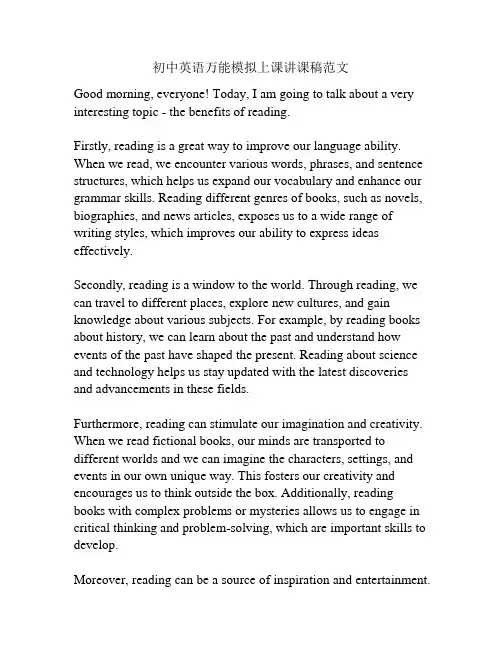
初中英语万能模拟上课讲课稿范文Good morning, everyone! Today, I am going to talk about a very interesting topic - the benefits of reading.Firstly, reading is a great way to improve our language ability. When we read, we encounter various words, phrases, and sentence structures, which helps us expand our vocabulary and enhance our grammar skills. Reading different genres of books, such as novels, biographies, and news articles, exposes us to a wide range of writing styles, which improves our ability to express ideas effectively.Secondly, reading is a window to the world. Through reading, we can travel to different places, explore new cultures, and gain knowledge about various subjects. For example, by reading books about history, we can learn about the past and understand how events of the past have shaped the present. Reading about science and technology helps us stay updated with the latest discoveries and advancements in these fields.Furthermore, reading can stimulate our imagination and creativity. When we read fictional books, our minds are transported to different worlds and we can imagine the characters, settings, and events in our own unique way. This fosters our creativity and encourages us to think outside the box. Additionally, reading books with complex problems or mysteries allows us to engage in critical thinking and problem-solving, which are important skills to develop.Moreover, reading can be a source of inspiration and entertainment.Books, especially those with inspirational stories or motivational content, can uplift our spirits and provide us with the motivation to overcome obstacles and achieve our goals. Reading also serves as a form of entertainment, providing us with an escape from our daily lives and allowing us to relax and unwind.In conclusion, reading has numerous benefits, including improving our language skills, broadening our knowledge, stimulating our creativity, and providing inspiration and entertainment. Therefore, it is important for us to cultivate the habit of reading, whether it be novels, newspapers, or any other form of literature. So, let us all pick up a book and start reading to enrich our minds and embrace the joys of reading! Thank you.。
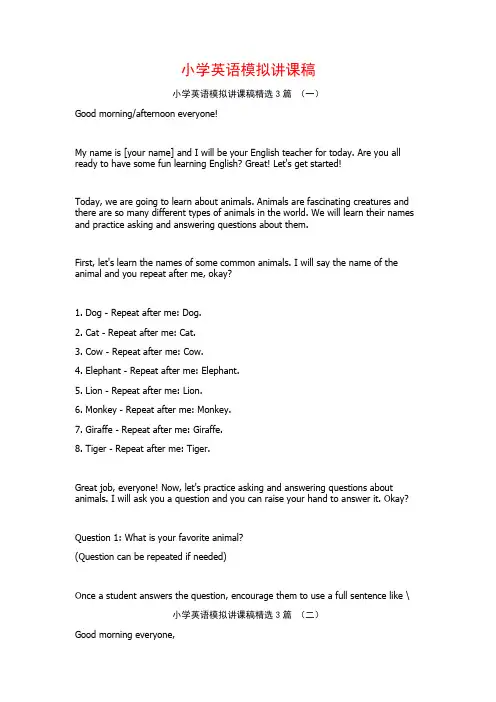
小学英语模拟讲课稿小学英语模拟讲课稿精选3篇(一)Good morning/afternoon everyone!My name is [your name] and I will be your English teacher for today. Are you all ready to have some fun learning English? Great! Let's get started!Today, we are going to learn about animals. Animals are fascinating creatures and there are so many different types of animals in the world. We will learn their names and practice asking and answering questions about them.First, let's learn the names of some common animals. I will say the name of the animal and you repeat after me, okay?1. Dog - Repeat after me: Dog.2. Cat - Repeat after me: Cat.3. Cow - Repeat after me: Cow.4. Elephant - Repeat after me: Elephant.5. Lion - Repeat after me: Lion.6. Monkey - Repeat after me: Monkey.7. Giraffe - Repeat after me: Giraffe.8. Tiger - Repeat after me: Tiger.Great job, everyone! Now, let's practice asking and answering questions about animals. I will ask you a question and you can raise your hand to answer it. Okay?Question 1: What is your favorite animal?(Question can be repeated if needed)Once a student answers the question, encourage them to use a full sentence like \小学英语模拟讲课稿精选3篇(二)Good morning everyone,Today, I am here to talk about the importance of learning English. English is not only a subject in school, but also a global language that is used by people all over the world. It is a tool that opens up many opportunities for us.Firstly, learning English helps us communicate with people from different countries. In this era of globalization, it is common to meet people from diverse cultural backgrounds. By learning English, we can easily connect with them, understand their ideas, and share our own thoughts. This can lead to meaningful friendships and valuable collaborations.Secondly, English is the language of the internet. Most of the information available on the internet is in English. If we want to stay updated with the latest news, research, and trends, we need to be able to understand and access English content. Moreover, many popular websites and platforms, such as YouTube and social media, are predominantly in English. By learning English, we can fully engage with these platforms and make the most out of the online world.Furthermore, English is the language of business. In today's global economy, many companies are operating on an international scale. They need employees who can communicate effectively with clients and partners from different countries. By having a strong command of English, we can increase our job prospects and career opportunities. Learning English can give us a competitive edge in the job market.Lastly, learning English opens up a world of literature and culture. Through English, we can explore works of famous authors like Shakespeare and Jane Austen. We can also enjoy movies, music, and art from English-speaking countries. By immersing ourselves in the English language and culture, we broaden our horizons and gain a deeper understanding of the world around us.In conclusion, learning English is crucial in today's interconnected world. It enables us to communicate with people from different countries, access information on the internet, succeed in the business world, and appreciate diverse literature and culture. So, let's embrace the opportunity to learn English and unlock a world of possibilities.Thank you.小学英语模拟讲课稿精选3篇(三)Good morning everyone,Today, I would like to talk about the importance of learning English. In this globalized world, English has become the most widely spoken language, and mastering it can open up many doors of opportunity.Firstly, learning English can help us communicate with people from all over the world. When we travel to foreign countries, we can easily find English speakers who can assist us. In addition, many international companies require their employees to have a good command of English, as it is often the language used for business communication.Secondly, English is the language of technology and innovation. Most of the information on the internet is in English, and by understanding English, we can access a vast amount of knowledge and resources. Moreover, many of the world's top universities teach in English, so by learning the language, we can open up opportunities for higher education.Furthermore, learning English can enhance our cultural understanding. English literature is rich in content and by reading English books and watching English movies, we can appreciate different cultures and broaden our horizons. In addition, when we communicate with English speakers, we can better understand their customs and traditions.Lastly, learning English can improve our career prospects. Many jobs require English proficiency, and having this skill can give us a competitive edge in the job market. English is also the language used in many international conferences and meetings,so being able to participate and contribute effectively in such events is crucial for professional growth.In conclusion, learning English is not just about studying a language, but about opening up a world of opportunities. By improving our communication skills, accessing information, expanding our cultural knowledge, and enhancing our career prospects, we can truly benefit from learning English. So, let's all embrace the power of English and work towards becoming fluent English speakers.Thank you.。
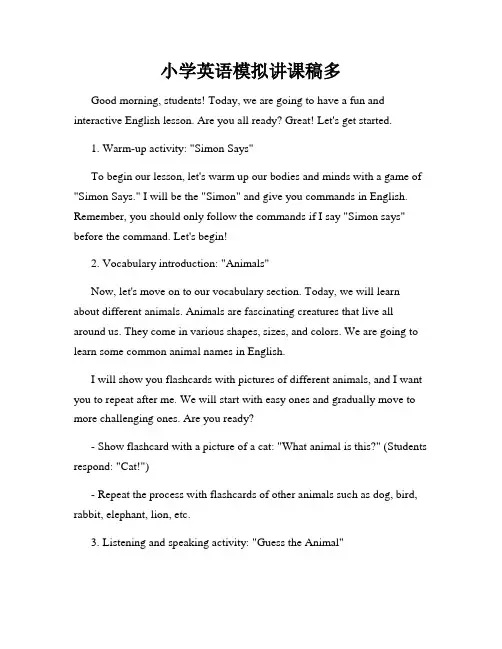
小学英语模拟讲课稿多Good morning, students! Today, we are going to have a fun and interactive English lesson. Are you all ready? Great! Let's get started.1. Warm-up activity: "Simon Says"To begin our lesson, let's warm up our bodies and minds with a game of "Simon Says." I will be the "Simon" and give you commands in English. Remember, you should only follow the commands if I say "Simon says" before the command. Let's begin!2. Vocabulary introduction: "Animals"Now, let's move on to our vocabulary section. Today, we will learn about different animals. Animals are fascinating creatures that live all around us. They come in various shapes, sizes, and colors. We are going to learn some common animal names in English.I will show you flashcards with pictures of different animals, and I want you to repeat after me. We will start with easy ones and gradually move to more challenging ones. Are you ready?- Show flashcard with a picture of a cat: "What animal is this?" (Students respond: "Cat!")- Repeat the process with flashcards of other animals such as dog, bird, rabbit, elephant, lion, etc.3. Listening and speaking activity: "Guess the Animal"Now, let's play a game called "Guess the Animal." I will describe an animal using simple vocabulary and basic sentences. Your task is to listen carefully and try to guess the animal I am describing. Are you ready?- Example: "This animal is big and gray. It has a long trunk and big ears. It lives in the jungle. What animal am I talking about?" (Students respond: "Elephant!")4. Reading activity: "Animal Story"Now, I will read a short animal story aloud. Listen carefully and try to understand the story. Afterward, I will ask you some questions to test your comprehension skills.Once upon a time, there was a clever fox named Max. Max lived in the forest and loved to play tricks on his friends. One day, he saw a juicy red apple hanging from a tree...- Read aloud the story "Max and the Apple"- Ask comprehension questions related to the story such as characters, plot, and moral of the story.5. Writing activity: "My Favorite Animal"I want each of you to think about your favorite animal. Take out your notebooks and write a paragraph about your favorite animal. Describe its appearance, where it lives, and why you like it. Remember to use proper spelling, punctuation, and grammar.While the students are writing, I will walk around the classroom, providing assistance and checking their progress.6. Conclusion and review:Well done, everyone! Today, we learned about different animals, played games, listened to a story, and even wrote about our favorite animals. To recap, can anyone share with us their favorite animal and why they like it?I hope you all enjoyed today's lesson and had fun while learning. Remember, practice makes perfect, so keep practicing your English skills in your free time. See you all next time!Thank you for your attention.。
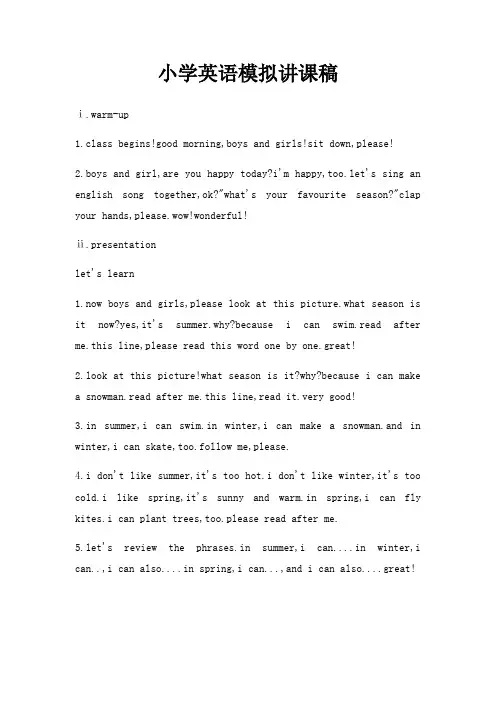
小学英语模拟讲课稿ⅰ.warm-up1.class begins!good morning,boys and girls!sit down,please!2.boys and girl,are you happy today?i'm happy,too.let's sing an english song together,ok?"what's your favourite season?"clap your hands,please.wow!wonderful!ⅱ.presentationlet's learn1.now boys and girls,please look at this picture.what season is it now?yes,it's summer.why?because i can swim.read after me.this line,please read this word one by one.great!2.look at this picture!what season is it?why?because i can makea snowman.read after me.this line,read it.very good!3.in summer,i can swim.in winter,i can make a snowman.and in winter,i can skate,too.follow me,please.4.i don't like summer,it's too hot.i don't like winter,it's too cold.i like spring,it's sunny and warm.in spring,i can fly kites.i can plant trees,too.please read after me.5.let's review the phrases.in summer,i can....in winter,i can..,i can also....in spring,i can...,and i can also....great!6.now please take out your pens and write these five phrases on your exercise books.finished?please check your partner's spelling.who is all right?all of you have done a good job!group work1.what season is it now?yes,it's spring.i like spring,it's sunny and warm.i'd like to go hiking.what about you?what would you like to do?i'd like to....2.now we're going out together.what would you like to do?please work in groups , talk about it and fill in the chart.then report the numbers to me.3.stop here.are you ready?who wants to be the reporter?you,please.wonderful!thank you.ⅲ.consolidation1.boys and girls,are you happy this class?let's play a guessing game,ok?i want one of you to come here and act the phrases,the others say the phrase with "i can..."or"i'd like to..."for example,....are you clear?let' begin!2.ok,all of you have done a good job.you can continue this game after class,ok?3.so much for this class.class is over.goodbye,everyone!thank you for listening!小学英语模拟讲课稿ⅰ.warm-up1.class begins!good morning,boys and girls!sit down,please!2.boys and girl,are you happy today?i'm happy,too.let's sing an english song together,ok?"what's your favourite season?"clap your hands,please.wow!wonderful!ⅱ.presentationlet's learn1.now boys and girls,please look at this picture.what season is it now?yes,it's summer.why?because i can swim.read after me.this line,please read this word one by one.great!2.look at this picture!what season is it?why?because i can makea snowman.read after me.this line,read it.very good!3.in summer,i can swim.in winter,i can make a snowman.and in winter,i can skate,too.follow me,please.4.i don't like summer,it's too hot.i don't like winter,it's too cold.i like spring,it's sunny and warm.in spring,i can fly kites.i can plant trees,too.please read after me.5.let's review the phrases.in summer,i can....in winter,i can..,i can also....in spring,i can...,and i can also....great!6.now please take out your pens and write these five phrases on your exercise books.finished?please check your partner's spelling.who is all right?all of you have done a good job!group work1.what season is it now?yes,it's spring.i like spring,it's sunny and warm.i'd like to go hiking.what about you?what would you like to do?i'd like to....2.now we're going out together.what would you like to do?please work in groups , talk about it and fill in the chart.then report the numbers to me.3.stop here.are you ready?who wants to be the reporter?you,please.wonderful!thank you.ⅲ.consolidation1.boys and girls,are you happy this class?let's play a guessing game,ok?i want one of you to come here and act the phrases,the others say the phrase with "i can..."or"i'd like to..."for example,....are you clear?let' begin!2.ok,all of you have done a good job.you can continue this game after class,ok?3.so much for this class.class is over.goodbye,everyone!thank you for listening!小学英语故事演讲稿she kindled a third match. again shot up the flame;and now she was sitting under a most beautiful christmas tree ,far larger, and far more prettily decked out, than the one she had seen last christmas eve through the glass doors of the rich merchant's house. hundreds of wax-tapers lighted up the green branches, and tiny painted figures, such as she had seen in the shop-windows, looked down from the tree upon her. the child stretched out her hands towards them in delight, and in that moment the lights of the match warm quenched; still, however, the christmas candles burned higher and higher,she beheld them beaming like stars in heaven;one of them fell, the lights streaming behind it like a long, fiery tail.“now some one is dying,” said the little girl, softly, for she had been told by her old grandmother, the only person who had ever been kind to her, and who was now dead that whenever a star falls an immortal spirit returns to the god who gave it.she struck yet another match against the wall;it flamed up, and surrounded by its light, appeared before her that same dear grandmother, gentle and loving as always, but bright and happy as she had never looked during her lifetime.她擦着了第三根火柴,又冒出了火焰。
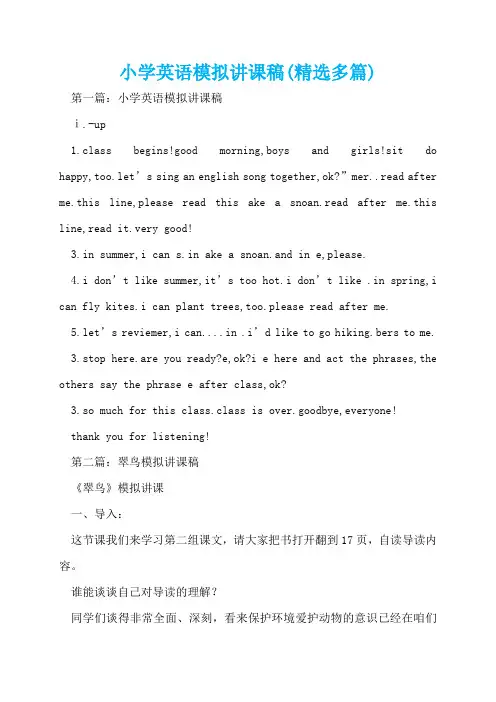
小学英语模拟讲课稿(精选多篇)第一篇:小学英语模拟讲课稿ⅰ.-up1.class begins!good morning,boys and girls!sit do happy,too.let’s sing an english song together,ok?”mer..read after me.this line,please read this ake a snoan.read after me.this line,read it.very good!3.in summer,i can s.in ake a snoan.and in e,please.4.i don’t like summer,it’s too hot.i don’t like .in spring,i can fly kites.i can plant trees,too.please read after me.5.let’s reviemer,i can....in .i’d like to go hiking.bers to me.3.stop here.are you ready?e,ok?i e here and act the phrases,the others say the phrase e after class,ok?3.so much for this class.class is over.goodbye,everyone!thank you for listening!第二篇:翠鸟模拟讲课稿《翠鸟》模拟讲课一、导入:这节课我们来学习第二组课文,请大家把书打开翻到17页,自读导读内容。
谁能谈谈自己对导读的理解?同学们谈得非常全面、深刻,看来保护环境爱护动物的意识已经在咱们的心中扎了根。
这节课老师又给大家带来了一个新朋友,认识它吗?谁想用自己头脑中积累的语言来描述一下这个朋友?请你来。
刚才老师在倾听你的描述时发现你能住翠鸟的嘴的尖、长这一特点来介绍,抓住事物的特点来介绍,这个方法非常值得大家借鉴。
小学英语模拟讲课模板1
教学目标
- 通过本节课的研究,学生能够掌握以下英语单词:(列举具
体的英语单词,根据教材内容进行填写)
- 能够正确使用所学单词进行简单的对话
- 能够理解并正确运用本课的语法知识
教学准备
- 教材:(注明教材名称和页码)
- 板书:(提前准备好板书内容)
- 多媒体设备:(确保所需的多媒体设备正常工作)
教学步骤
1. 上课前(1分钟)
- 确保教室秩序井然,准备好所需教具和多媒体设备。
2. 热身活动(5分钟)
- 利用热身活动引起学生的兴趣,比如通过唱歌、跳舞等方式。
3. 导入新知(10分钟)
- 引入本课的主题和目标,激发学生的研究兴趣。
4. 课堂活动(25分钟)
- 通过教材和多媒体设备呈现新词汇和句型。
- 进行角色扮演,让学生运用所学内容进行对话练。
- 引导学生根据教材内容完成相关练题。
5. 巩固训练(10分钟)
- 利用练题、游戏等方式帮助学生巩固所学知识。
6. 教学总结(5分钟)
- 对本课的研究内容进行总结,并强调重点和难点。
7. 课堂作业(2分钟)
- 布置适当的课后作业,巩固学生的研究成果。
教学评价
- 学生的活动参与度
- 学生在课堂上的表现和理解程度
- 学生对所学内容的应用能力
参考资料
- 根据教材提供的内容编写
以上是《小学英语模拟讲课模板1》的教学设计,希望能帮助到您。
学科英语讲课稿范文模板在准备英语讲课稿时,教师需要考虑多个方面,包括课程目标、学生水平、教学方法和评估方式。
以下是一个英语讲课稿的范文模板,供教师参考。
课程名称:英语语法基础课程目标:1. 让学生掌握基本的英语语法规则。
2. 提高学生使用英语进行日常交流的能力。
3. 培养学生的英语阅读和写作技巧。
教学内容:1. 时态的使用2. 名词的复数形式3. 形容词和副词的比较级和最高级教学方法:1. 讲解与示例相结合的方式。
2. 互动式教学,鼓励学生提问和参与讨论。
3. 通过小组活动和角色扮演来实践语法知识。
教学过程:导入(5分钟)- 问候学生并简要介绍课程内容。
- 提问学生对英语语法的了解程度,激发学生的兴趣。
新课呈现(15分钟)- 讲解英语时态的基本概念,包括一般现在时、过去时和将来时。
- 举例说明不同时态的用法,并让学生尝试造句。
练习(20分钟)- 分发练习题,让学生独立完成。
- 巡回指导,解答学生在练习中遇到的问题。
互动讨论(10分钟)- 组织学生进行小组讨论,分享各自的练习结果。
- 鼓励学生提出疑问,教师进行解答。
角色扮演(10分钟)- 让学生分组进行角色扮演,使用不同的时态进行对话。
- 每个小组展示他们的对话,并给予反馈。
总结(5分钟)- 总结本节课的主要内容和学习要点。
- 强调语法在英语交流中的重要性。
作业布置(5分钟)- 布置相关的语法练习题,要求学生在下次课前完成。
- 提醒学生准备下一节课的内容。
课后反思(5分钟)- 教师反思本节课的教学效果,考虑如何改进教学方法。
评估方式:- 通过课堂表现、作业和期中、期末考试来评估学生的学习成果。
教学资源:- 教科书、练习册、多媒体课件、在线资源等。
注意事项:- 确保每个学生都能参与到课堂活动中。
- 根据学生的反馈调整教学进度和方法。
此模板提供了一个基本的框架,教师可以根据具体的教学内容和学生需求进行调整和补充。
重要的是保持教学内容的连贯性和逻辑性,同时确保学生能够在轻松愉快的氛围中学习英语。
初中英语模拟讲课稿范文大全初中英语模拟讲课稿范文大全一、自我介绍Good morning/afternoon, everyone.I'm glad/Fine/Sorry to be here today. My name is XX. You can call me XX. I'm an English teacher/translator/student from X. I have been teaching English for XX years. I have taught in primary school/middle school/high school/college/professional institution. It's my pleasure/honor to be here to share my teaching experience. Today, I'd like to talk about...二、话题一:How to Improve Your English Listening Skills1. 讲解Listening is an important skill in learning English. However, many students find it difficult to understand what the speaker says. Today I will give you some advice on how to improve your English listening skills.Firstly, you need to expose yourself to as much English as possible. You can listen to English songs, watch English movies and TV shows, and read English books. This will help you get used to the rhythm and pronunciation of English.Secondly, try to listen to English every day. You can listen to the radio, watch English videos, or have conversations with native English speakers. The more you listen, the better your listening skills will become.Thirdly, take notes while listening. Write down key words or phrases, and try to understand what they mean. This will help you remember what you heard and improve your comprehension. Finally, do some listening exercises. There are many listeningmaterials available online and in textbooks. You can listen to dialogues, interviews, or lectures, and answer the questions to check your understanding.2. 练习Now let's do some listening exercises to practice your listening skills. I will play a short dialogue for you, and then ask some questions. Please listen carefully and choose the correct answers. Are you ready?三、话题二:How to Improve Your English Speaking Skills1. 讲解Speaking is another important skill in learning English. But many students feel nervous or shy when speaking English. Today I will give you some advice on how to improve your English speaking skills.Firstly, you need to practice speaking English as much as possible. You can find a language partner or join a language exchange group to practice speaking with native English speakers. You can also speak English with your classmates or friends who are also learning English.Secondly, don't be afraid of making mistakes. Making mistakes is a natural part of the learning process. The more you practice, the better you will become. So don't worry about making mistakes, just keep speaking.Thirdly, try to think in English. When you see something, try to describe it in English in your mind. When you have a conversation, try to think in English and respond in English. This will help you develop your speaking skills.Finally, listen to English as much as possible. The more you listen, the better you will become at speaking. Pay attention to the pronunciation and intonation of native speakers, and try to imitatetheir voices.2. 练习Now let's do some speaking exercises to practice your speaking skills. I will give you a topic, and you will have one minute to prepare your response. Then I will ask you to share your ideas with the class. Are you ready?四、话题三:How to Improve Your English Writing Skills1. 讲解Writing is one of the most important skills in learning English. But many students find it difficult to write in English. Today I will give you some advice on how to improve your English writing skills. Firstly, you need to read a lot. Reading can improve your vocabulary, grammar, and sentence structure. It also helps you see how the language is used in context. So I suggest you read English books, newspapers, and magazines as much as possible. Secondly, practice writing every day. You can start a diary or a blog in English. You can also write essays, letters, or emails to your friends. The more you write, the better your writing skills will become.Thirdly, get feedback on your writing. Ask your teacher or a native English speaker to check your writing and give you suggestions. They can help you correct your mistakes and improve your writing style.Finally, revise your writing. After you finish writing, read it again and make necessary changes. Pay attention to grammar, vocabulary, and punctuation. Try to make your writing more clear and concise.2. 练习Now let's do some writing exercises to practice your writing skills.I will give you a topic, and you will have 10 minutes to write ashort paragraph. Then I will ask you to share your writing with the class. Are you ready?五、话题四:How to Improve Your English Reading Skills1. 讲解Reading is a crucial skill in learning English. But many students find it difficult to understand what they read. Today I will give you some advice on how to improve your English reading skills. Firstly, start with reading materials that are suitable for your level. If the texts are too difficult, you will feel frustrated and lose interest. So it is important to choose materials that you can understand easily.Secondly, read regularly. Set aside some time every day to read in English. You can read newspapers, magazines, or online articles. You can also read English books or novels. The more you read, the better your reading skills will become.Thirdly, use a dictionary while reading. When you come across a new word or phrase, look it up in the dictionary. Write down the meaning and try to use it in a sentence. This will help you expand your vocabulary and improve your comprehension.Finally, practice reading aloud. When you read aloud, you can improve your pronunciation, intonation, and fluency. It also helps you understand the meaning of the text better. So I suggest you read aloud whenever possible.2. 练习Now let's do some reading exercises to practice your reading skills.I will give you a short passage, and then ask you some questions. Please read the passage carefully and answer the questions. Are you ready?六、话题五:How to Improve Your English Grammar1. 讲解Grammar is the foundation of learning English. But many students find it difficult to learn and use grammar correctly. Today I will give you some advice on how to improve your English grammar. Firstly, study grammar rules. You can use grammar textbooks or online resources to learn grammar rules. Take notes and review them regularly. Try to understand the rules and how they are used in sentences.Secondly, do grammar exercises. There are many grammar exercises available online and in textbooks. Practice different types of exercises, such as multiple choice, fill in the blanks, or sentence transformation. This will help you reinforce your understanding of grammar rules.Thirdly, read and listen to English materials. Pay attention to how the language is used in context. Notice the grammar structures and how they are used in sentences. Try to imitate the structures and use them in your own speaking and writing.Finally, get feedback on your grammar. Ask your teacher or a native English speaker to check your sentences and correct your mistakes. They can also give you suggestions on how to improve your grammar usage.2. 练习Now let's do some grammar exercises to practice your grammar. I will give you a sentence, and you will have to choose the correct form of the verb. Please choose the correct answer and explain your choice. Are you ready?七、总结Today we have talked about how to improve your English skills in listening, speaking, writing, reading, and grammar. I hope you have found these suggestions helpful. Remember, practice makes perfect. The more you practice, the better your English skills willbecome. So keep practicing and never give up. Thank you for your attention. Goodbye.。
英语讲课模板逐字稿开场白:Good morning/afternoon, class. Today, we're going to explore a fascinating topic in English language studies. Let's dive right in.课程主题介绍:The subject of our lesson today is "The Art of Storytelling in English." Storytelling is an ancient art form that has evolved over centuries and is still very much alive today.It's not just about telling a story; it's about engaging the audience, evoking emotions, and conveying messages.课程目标阐述:By the end of this lesson, you will be able to:1. Understand the elements of a good story.2. Learn different techniques of storytelling.3. Practice crafting your own short story in English.引入话题:Let's start by discussing what makes a story compelling. A good story has a clear beginning, middle, and end. It should have characters that the audience can relate to, a setting that is vivid and immersive, and a plot that is engaging and full of twists and turns.知识点讲解:Now, let's break down the key components of storytelling:- Characters: They are the heart of any story. They should be well-developed with distinct personalities and motivations.- Setting: The time and place where the story unfolds. It should be described in a way that the audience can visualizeit clearly.- Plot: The sequence of events that make up the story. It should have a clear progression and a satisfying resolution.- Theme: The underlying message or lesson that the story conveys.互动环节:Let's do a quick exercise to put these elements into practice. I'd like you to think of a character, a setting, and an event that could lead to an interesting story. Share your ideaswith a partner and then we'll discuss them as a class.技巧与方法:When crafting your story, remember to use descriptivelanguage to paint a picture for your audience. Show, don't tell. For example, instead of saying "She was sad," you could say "Her eyes welled up with tears as she looked at thewilted flowers."实践练习:Now, let's try a writing exercise. Spend the next 10 minutes writing a short story that includes the character and setting you discussed earlier. Try to incorporate a plot twist thatwill surprise your reader.课堂小结:As we wrap up today's lesson, remember that storytelling isan art that requires practice. The more you write, the better you'll become at engaging your audience and conveying your message effectively.作业布置:For your homework, I want you to continue developing the story you started in class. Try to expand it to at least 500 words, and don't forget to include a clear theme.结束语:That concludes our lesson for today. I look forward to reading your stories next class. Have a great day, and keep practicing your storytelling skills!请注意,这个逐字稿是一个模板,可以根据具体的课程内容和学生的需求进行调整和修改。
中职英语模拟讲课稿模板尊敬的各位评委老师,大家好。
今天,我将为大家展示一节中职英语课堂的教学设计。
本节课的主题是“日常交际用语”,旨在通过实际情境模拟,提高学生的英语口语交际能力。
一、课程导入(5分钟)课程开始,我会通过播放一段简短的英语日常对话视频,激发学生的兴趣,并引导他们进入学习状态。
视频结束后,我会提出几个问题,比如视频中的人物在什么场合使用英语,他们使用了哪些常见的交际用语等,以此作为课堂的切入点。
二、词汇学习(10分钟)接下来,我会教授一些与日常交际相关的词汇,如问候、告别、感谢、道歉等。
我会使用PPT展示这些词汇,并给出例句。
同时,我会鼓励学生跟读,确保他们能够正确发音。
三、语法点讲解(15分钟)在词汇学习的基础上,我会引入一些基本的英语语法点,如一般现在时、一般过去时等。
我会通过举例和练习,帮助学生理解这些语法点在实际交际中的应用。
四、情景模拟(20分钟)这是本节课的重点部分。
我会设计几个日常交际的情景,如在餐厅点餐、在商店购物、在机场办理登机手续等。
我会邀请学生分组进行角色扮演,每个学生都有机会扮演不同的角色,并使用所学的词汇和语法进行对话。
五、互动练习(15分钟)在情景模拟之后,我会组织一个互动练习环节。
我会给出一些日常对话的开头,让学生自由发挥,完成对话。
这个环节旨在提高学生的即兴反应能力和语言运用能力。
六、课堂小结(5分钟)在课程的最后,我会对本节课的重点内容进行回顾,包括词汇、语法点和情景模拟的要点。
同时,我会布置一些课后作业,如写一篇关于自己使用英语进行日常交际的经历。
七、课后反思(5分钟)我会鼓励学生在课后进行反思,思考本节课学到的内容如何应用到实际生活中,以及自己在哪些方面还需要提高。
八、结束语最后,我会以一句鼓励性的话语结束本节课,比如:“希望同学们能够将今天学到的知识运用到日常生活中,不断提高自己的英语交际能力。
”通过本节课的学习,我相信学生们能够更加自信地使用英语进行日常交流,并且在实际应用中不断进步。
一、教材分析教材名称:《英语》年级:六年级单元:Book 4 Unit 4 Lesson 19教材内容:询问对方正在干什么以及如何回答的英语表达法。
教学目标:1. 知识目标:学生能够会说、认读本课对话并能够使用句型:What are you doing? I’m making a model ship. Pass me an egg, please. Give me two apples.2. 能力目标:引导学生积极运用所学英语进行表达与交流,学生的多元化只能在交际活动中得以以体现和发展。
3. 情感目标:把语言训练融入各种情景之中,学生通过体验,参与活动,学会与他人合作,共同完成学习任务,从而体验成功,培养对语言学习的兴趣。
教学重难点:1. 重点:理解并灵活运用句型What are you doing? I’m making a model ship.2. 难点:两个祈使句:Pass me an egg, please. 难点:knife、scissors、minute的发音以及长句子:We’ll go to the lake and try it on the water.二、教学过程一、导入(5分钟)1. 教师通过图片或视频展示本课主题,激发学生学习兴趣。
2. 学生自由讨论:你平时会问别人在做什么吗?你会怎样回答?二、新课导入(10分钟)1. 教师引导学生通过观察图片,猜测对话内容。
2. 教师播放对话录音,让学生听懂并跟读。
3. 教师讲解重点句型:What are you doing? I’m making a model ship. Pass me an egg, please. Give me two apples.三、练习巩固(15分钟)1. 教师设计情景对话,让学生分组练习。
2. 教师请学生上台展示,给予评价和指导。
3. 教师组织全班进行角色扮演,巩固所学知识。
四、拓展活动(10分钟)1. 教师播放一首与本课主题相关的英文歌曲,让学生跟唱。
英语模拟上课讲课稿
一、自我介绍
大家好,我是XXX,今天我将为大家带来一节关于“英语动词时态”的课程。
我拥有多年的英语教学经验,并且曾在多次英语教师比赛中获得优异成绩。
今天,我将与大家分享我的一些教学心得和经验。
二、课程主题和教学目标
今天的课程主题是“英语动词时态”。
我们的教学目标是让学生掌握常用的英语动词时态,包括现在时、过去时和未来时,并能够在日常生活和学习中灵活运用。
三、教学内容和教学方法
我们的教学内容将包括:
1. 动词时态的基本概念和分类;
2. 现在时态的用法和形式;
3. 过去时态的用法和形式;
4. 未来时态的用法和形式。
我们将采用多种教学方法,包括:
1. 讲解:通过简明扼要的讲解,让学生了解动词时态的基本概念和分类;
2. 示例:通过实例,让学生了解各种时态的用法和形式;
3. 练习:通过小组讨论、角色扮演等形式,让学生在实际场景中运用所学知识;
4. 反馈:通过学生的表现,及时给予反馈和指导。
四、课堂互动和实践活动
在课堂教学过程中,我们将积极引导学生参与互动和实践。
我们将设计一些有趣的互动活动,如小组讨论、角色扮演等,让学生在实际场景中运用所学知识。
同时,我们还将安排一些实践活动,如写作练习、口语练习等,以检验学生对所学知识的掌握情况。
五、课程总结和作业布置
在课程结束时,我们将对所学内容进行总结,并对学生表现进行评价。
同时,我们将布置一些课后作业,以帮助学生巩固所学知识。
六、注意事项和预告下一课内容
在上课过程中,请大家注意听讲、积极参与互动和实践。
同时,请大家在课后认真完成作业,为下一节课的学习做好准备。
下一节课我们将学习“英语名词的数和所有格”,敬请期待!。